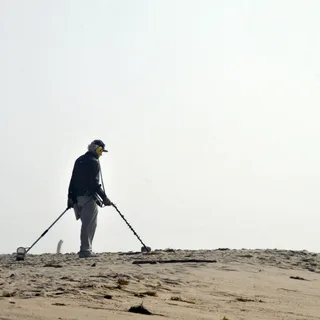Black sand gold is a rare and valuable material that is often overlooked by many people. However, uncovering the hidden treasures of black sand gold can be a rewarding and lucrative experience. In this article, we will explore the various methods and techniques for discovering and extracting black sand gold, as well as the potential benefits and uses of this unique resource. Join us as we delve into the world of black sand gold and uncover its hidden treasures.
Uncovering the Hidden Treasures of Black Sand Gold is a book that delves into the often overlooked world of gold mining in black sand deposits. The book discusses the unique challenges and rewards of mining for gold in these less commonly explored areas, providing valuable insight and information for both experienced and novice miners. The author shares their first-hand experiences and knowledge, offering practical tips and techniques for effectively uncovering and extracting gold from black sand deposits. Whether you are a seasoned prospector or just starting out, this book is a valuable resource for understanding and navigating the world of black sand gold mining.
Uncovering the Secret of Black Sand Gold Deposits

Uncovering the Secret of Black Sand Gold Deposits involves understanding the geological processes that lead to the concentration of gold in black sand deposits. Black sand is a common indicator of gold-bearing deposits and can contain high concentrations of gold particles. These deposits form as a result of the erosion and weathering of gold-bearing rocks, which release the gold into the surrounding environment. Understanding the processes that lead to the formation of black sand gold deposits is crucial for successful gold exploration and mining. Techniques such as panning, sluicing, and dredging are commonly used to extract gold from black sand deposits. Additionally, advanced exploration and mining methods, such as geophysical surveys and remote sensing technologies, are employed to locate and characterize black sand gold deposits.
Prospecting for Black Sand Gold: Where to Start

Prospecting for black sand gold can be a lucrative venture if you know where to start. One of the best places to begin searching for black sand gold is in areas where rivers and streams have deposited it over time. Look for stretches of black sand along the banks of rivers and streams, as well as in areas with heavy mineralization. Black sand is often found in conjunction with other heavy minerals such as magnetite and hematite, so keep an eye out for these as well. Additionally, old mining and gold rush sites can be a good place to start prospecting for black sand gold, as the remnants of past mining activity may have left behind deposits of black sand.
The Mystique of Black Sand Gold Mining
See also: Discovering Rare Large Gold Nuggets in California's Sierra Nevada Mountains

The mystique of black sand gold mining comes from the allure of finding a rare and valuable substance in the unique and mesmerizing setting of black sand beaches. The process of extracting gold from black sand can be both challenging and rewarding, as miners navigate the complexities of separating the precious metal from the surrounding materials. The idea of uncovering gold from these exotic locations adds to the intrigue and fascination of black sand gold mining. The black sand itself is also a mysterious and captivating element, as it is formed from volcanic minerals and creates a striking contrast against the shimmering gold. Overall, the mystique of black sand gold mining lies in the combination of adventure, discovery, and the potential for great reward.
How to Extract Fine Gold from Black Sand

To extract fine gold from black sand, you can use various methods such as panning, sluicing, or using a gold wheel. Panning involves using a shallow pan filled with water to separate the gold from the black sand. Sluicing involves using a sluice box to channel water and separate the gold from the black sand. A gold wheel is a mechanical device that uses centrifugal force to separate the gold from the black sand. Whichever method you choose, it is important to carefully remove the black sand and any other impurities to extract the fine gold.
Understanding the Geology of Black Sand Gold
Understanding the geology of black sand gold involves studying the mineral composition of the black sand, as well as the geological processes that lead to the formation of black sand deposits. Black sand is often composed of heavy minerals such as magnetite, ilmenite, and hematite, which are associated with gold deposits. Geologists analyze the distribution and concentration of these minerals to understand the potential for gold occurrence in black sand deposits. Additionally, the study of the geological history of an area can provide insights into the processes that have concentrated gold and other heavy minerals in black sand deposits. This understanding can help in the exploration and extraction of black sand gold deposits.
The Rich History of Black Sand Gold Discoveries
The rich history of black sand gold discoveries dates back to ancient times, with evidence of black sand being used by early civilizations such as the Egyptians, Greeks, and Romans to extract gold. The presence of black sand as an indicator of gold deposits has been noted in various historical accounts, including during the California Gold Rush and the Klondike Gold Rush. Black sand is formed from volcanic minerals such as magnetite, ilmenite, and hematite, which are often found in areas with significant gold deposits. Prospectors and miners have long recognized the association between black sand and gold, leading to the development of various techniques and methods for extracting gold from black sand. In addition to its historical significance, black sand gold discoveries continue to be a focus of modern-day prospecting and mining efforts. The unique properties of black sand make it a valuable indicator for identifying potential gold-bearing areas, and advancements in technology have allowed for more precise and efficient extraction methods. Overall, the rich history of black sand gold discoveries highlights the enduring connection between black sand and gold, and the significance of this association in the field of prospecting and mining.
Equipment Needed for Black Sand Gold Extraction
To extract gold from black sand, specialized equipment is necessary. This includes a gold pan or similar device for manually separating the gold from the black sand, a sluice box or suction dredge for more efficient extraction, and a metal detector to help locate gold deposits within the black sand. Additionally, a magnet and a snuffer bottle can be useful for collecting and removing the tiny gold particles from the black sand. It is important to use equipment specifically designed for gold extraction to ensure successful and efficient results.
The Economic Impact of Black Sand Gold Mining
See also: Find Your Next Gold Detector Online: Top 5 Choices
Black sand gold mining can have significant economic impacts on the areas where it is practiced. This type of mining can lead to increased employment opportunities in the local community, as well as increase in local businesses to support the mining operations. Additionally, the mining activity can result in increased infrastructure development, such as roads and ports, which can benefit the local economy. However, there are also potential negative economic impacts associated with black sand gold mining. These can include environmental damage, loss of agricultural land, and displacement of local communities. Furthermore, the economic benefits of black sand gold mining may not always be evenly distributed, leading to social and economic inequalities within the affected communities. It is important for governments and mining companies to carefully consider the economic impact of black sand gold mining and to implement measures to mitigate any potential negative effects. This can include conducting comprehensive impact assessments, developing sustainable mining practices, and ensuring fair compensation and benefit sharing for local communities affected by the mining activity.
The Unique Characteristics of Black Sand Gold
Black sand gold is unique in that it is a mixture of gold and magnetite, a black mineral that is often found in beach sands and other placer deposits. This combination gives black sand gold its distinct appearance and makes it more challenging to extract and separate from the surrounding minerals. Additionally, black sand gold can be found in various concentrations, with some deposits containing higher levels of gold and others containing more magnetite. This variability makes black sand gold mining a specialized and often lucrative endeavor for those willing to put in the effort to recover the precious metal.
How to Identify Black Sand Gold Deposits in Rivers
Black sand gold deposits can be identified in rivers by the presence of dark-colored sand, which is often magnetic, and shiny particles of gold. This type of sand often accumulates in specific areas where gold is concentrated, such as inside bends of rivers, in crevices, and behind large rocks. To identify these deposits, it is important to use a gold pan or sluice box to separate the black sand from the gold particles, as the heavy nature of gold causes it to settle at the bottom of these devices while the lighter black sand is washed away. Additionally, using a metal detector can help to pinpoint areas with gold deposits in rivers where black sand is present.
placer gold,
Placer gold is gold that has been eroded from its original source and deposited by natural forces, typically in rivers and streams. This type of gold is often found in the form of nuggets or flakes and can be easily extracted through panning or sluicing. Placer mining has been a popular method for prospectors and miners to find gold, as it does not require expensive equipment or extensive expertise. Historically, placer deposits have been the source of a significant amount of the world's gold supply.
